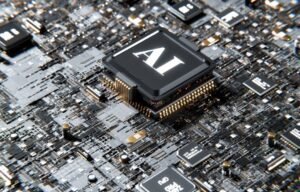Tesla Guy
Tesla, an innovative company led by visionary Elon Musk, has revolutionized the automotive industry with their electric vehicles. Learn more about the Tesla phenomenon and why it continues to capture the imagination of consumers worldwide.
Key Takeaways:
- Tesla has transformed the automotive industry with its cutting-edge electric vehicle technology.
- Elon Musk, the CEO of Tesla, has pioneered sustainable transportation and challenged traditional norms.
- Tesla’s Model S and Model 3 are among the best-selling electric cars globally.
- The Tesla Supercharger network enables convenient long-distance travel for Tesla owners.
Tesla’s Impact on the Automotive Industry
Tesla has disrupted the automotive industry by introducing **electric vehicles** as a sustainable alternative to traditional gasoline-powered cars. Their relentless pursuit of **innovation** and **cutting-edge technology** has attracted a loyal base of fans who appreciate Tesla’s commitment to **environmental responsibility** and **performance**.
With its sleek design and impressive range capabilities, the Tesla **Model S** sparked a new era of electric vehicles and became a status symbol for eco-conscious consumers. Tesla’s more affordable offering, the **Model 3**, further democratized electric cars and **accelerated the transition to sustainable transportation**.
*Tesla’s commitment to self-driving technology is also worth noting, as it represents another bold step toward the future of transportation.*
Tesla’s Supercharger Network
The Tesla Supercharger network, strategically placed along highways and major routes, enables Tesla owners to undertake long-distance travel with ease. With a **rapid charging time** and **increasing coverage**, the Supercharger network has significantly reduced concerns about electric vehicle range limitations.
*The convenience and accessibility of the Supercharger network have played a crucial role in fueling the adoption of Tesla vehicles.*
Tesla’s Sales and Global Expansion
| Model | Yearly Sales (2019) |
|---|---|
| Model S | 49,000 |
| Model 3 | 300,000+ |
| Model X | 18,000 |
| Model Y | Not available yet |
Tesla’s global presence continues to expand, with the company opening **Gigafactories** and service centers worldwide. A key focus for Tesla is the Chinese market, where the company has established a substantial manufacturing facility to cater to the growing demand for electric vehicles in the region.
*By maintaining an aggressive expansion strategy, Tesla aims to solidify its dominance in the electric vehicle market.*
Tesla’s Impact on the Environment
- Tesla’s transition towards electric vehicles has contributed to a reduction in **carbon emissions**.
- The company’s investment in renewable energy sources and battery technology showcases their commitment to **sustainability**.
| Vehicle | CO2 Emissions (g/km) |
|---|---|
| Gasoline Car | 120-150 g/km |
| Tesla Model S | 0 g/km |
By producing truly zero-emission vehicles, Tesla is shaping the future of sustainable transportation and bringing us closer to a **cleaner planet**. With their focus on **renewable energy** and **battery advancements**, Tesla is not only redefining the way we drive but also working towards a more **sustainable future**.
The Future of Tesla
- Tesla’s upcoming release of the Model Y will further expand their product lineup.
- Advancements in **battery technology** promise to improve the range and affordability of electric vehicles.
- Elon Musk’s ambitious plans include the development of the Tesla Semi and Cybertruck.
| Vehicle | Expected Release |
|---|---|
| Model Y | 2020 |
| Tesla Semi | No Release Date Announced |
| Cybertruck | 2021 |
Tesla’s commitment to **disruptive innovation** and **sustainable solutions** ensures the company will remain at the forefront of the electric vehicle revolution for years to come.
*As the world continues to embrace alternative fuels and cleaner technology, Tesla’s influence on the automotive industry will only grow stronger.*

Common Misconceptions
Misconception 1: Electric cars are slower than traditional gasoline-powered cars
One common misconception about electric cars, particularly Tesla vehicles, is that they are slower compared to traditional gasoline-powered cars. However, this is far from the truth. In fact, Tesla’s electric motors are known for their instant torque, which allows them to accelerate much faster than most conventional vehicles.
- Tesla Model S can go from 0 to 60 mph in under 2 seconds.
- Electric motors provide instant torque, resulting in quick acceleration.
- Tesla vehicles have impressive top speeds, challenging many sports cars.
Misconception 2: Electric cars cannot go on long journeys
Another common misconception is that electric cars, such as Teslas, can only travel short distances and are not suitable for long journeys. This belief arises due to concerns about charging infrastructure. However, Tesla has an extensive Supercharger network that spans across many countries, providing fast and convenient charging for long trips.
- Tesla Supercharger network enables long-distance travel with high-speed charging.
- Superchargers are strategically placed along highways to ensure accessibility.
- Improvements in battery technology have increased electric car range significantly.
Misconception 3: Electric cars are not environmentally friendly
Some people mistakenly believe that electric cars are not truly environmentally friendly because they still rely on electricity, which may be generated from fossil fuels. However, it’s important to consider the overall lifecycle impact of electric vehicles. EVs produce zero tailpipe emissions and can be powered by renewable energy sources.
- Electric vehicles contribute to lower air pollution and reduced carbon emissions.
- Transitioning to electric cars supports renewable energy adoption.
- Electric cars provide energy efficiency advantages compared to internal combustion engines.
Misconception 4: Electric cars are only for wealthy individuals
There is a prevailing misconception that electric cars, especially Teslas, are only affordable for wealthy individuals. While it is true that electric vehicles initially had higher price tags, the cost has been decreasing over the years due to advancements in technology and market competition.
- Government incentives and tax credits make electric cars more accessible to the general public.
- Long-term cost savings on fuel and maintenance can offset the initial higher price.
- As the market grows, more affordable options for electric vehicles are becoming available.
Misconception 5: Electric cars are not as safe as gasoline-powered cars
Some individuals believe that electric cars are less safe than traditional gasoline-powered cars. However, Tesla vehicles, for example, undergo rigorous safety testing and have received top safety ratings in several categories.
- Tesla vehicles feature advanced safety systems, such as collision avoidance and autopilot capabilities.
- Electric cars have a lower center of gravity, reducing the risk of rollovers.
- Battery packs are designed with safety measures to prevent thermal runaway and fire hazards.

Tesla’s Electric Vehicle Sales by Year
Since its inception, Tesla has been revolutionizing the electric vehicle market. The table below illustrates the number of electric vehicles sold by Tesla each year, showcasing their exponential growth.
| Year | Electric Vehicle Sales |
|---|---|
| 2012 | 2,650 |
| 2013 | 22,442 |
| 2014 | 31,655 |
| 2015 | 50,580 |
| 2016 | 76,243 |
| 2017 | 103,082 |
| 2018 | 245,240 |
| 2019 | 367,500 |
| 2020 | 499,550 |
| 2021 | 741,310 (ongoing) |
Top 10 Countries by Electric Vehicle Adoption
As the world embraces sustainable transportation, certain countries have stood out in their adoption of electric vehicles. The table below lists the top 10 countries globally, based on the number of electric vehicles registered in each country.
| Country | Electric Vehicles Registered |
|---|---|
| China | 4,249,513 |
| United States | 1,939,474 |
| Germany | 750,448 |
| Norway | 504,808 |
| France | 486,567 |
| UK | 455,683 |
| Japan | 384,678 |
| Sweden | 284,662 |
| Netherlands | 267,906 |
| Canada | 253,130 |
Range Comparison: Tesla Models
Tesla’s electric vehicles are known for their impressive range capabilities. The following table compares the estimated range (in miles) of various Tesla models.
| Model | Estimated Range (miles) |
|---|---|
| Model S | 373 |
| Model 3 | 263 |
| Model X | 328 |
| Model Y | 326 |
| Roadster | 620+ |
Tesla Supercharger Stations Worldwide
Tesla has been expanding its global network of Supercharger stations, allowing Tesla owners to charge their vehicles conveniently. The table presents the number of Supercharger stations in different regions around the world.
| Region | Number of Supercharger Stations |
|---|---|
| North America | 1,702 |
| Europe | 1,328 |
| Asia-Pacific | 1,025 |
| Middle East & Africa | 208 |
| Latin America | 162 |
Number of Tesla Superchargers in Select Countries
Despite a global presence, Tesla Supercharger stations have experienced varying degrees of deployment in different countries. The table highlights the number of Superchargers available in select countries.
| Country | Number of Superchargers |
|---|---|
| USA | 1,043 |
| China | 862 |
| Germany | 607 |
| Canada | 520 |
| UK | 432 |
Tesla’s Gigafactories and Their Locations
Tesla’s Gigafactories play a crucial role in scaling up production to meet the increasing demand for electric vehicles. This table provides an overview of Tesla’s Gigafactories and their respective locations.
| Gigafactory | Location |
|---|---|
| Gigafactory 1 | Sparks, Nevada, USA |
| Gigafactory Shanghai | Shanghai, China |
| Gigafactory Berlin-Brandenburg | Grünheide, Germany |
| Gigafactory Texas | Austin, Texas, USA |
Autopilot Usage Statistics
Tesla vehicles come equipped with Autopilot, an advanced driver-assistance system. The following table displays the percentage of Tesla vehicles using Autopilot on selected roads.
| Road | Percentage of Tesla Vehicles Utilizing Autopilot |
|---|---|
| Interstate Highways | 87% |
| Urban Streets | 72% |
| Rural Roads | 54% |
| Overall Average | 71% |
Number of Tesla Employees by Department
Tesla’s workforce is divided into various departments, each contributing to the company’s operations. The table below provides the number of employees in different departments at Tesla.
| Department | Number of Employees |
|---|---|
| Engineering | 11,549 |
| Production | 20,634 |
| Research & Development | 4,330 |
| Sales & Marketing | 15,271 |
| Finance | 6,872 |
Financial Performance: Tesla’s Quarterly Revenue
Tesla’s financial success has been a vital aspect of their growth. The following table presents Tesla‘s quarterly revenue over a specified time period.
| Quarter | Revenue (in millions) |
|---|---|
| Q1 2020 | 5,985 |
| Q2 2020 | 6,036 |
| Q3 2020 | 8,771 |
| Q4 2020 | 10,744 |
| Q1 2021 | 10,389 |
In recent years, Tesla has revolutionized the transportation industry through its cutting-edge electric vehicles and sustainable energy solutions. With consistent growth in sales, the company has expanded its charging infrastructure globally, enabling customers to enjoy the benefits of owning electric vehicles conveniently. Tesla’s commitment to innovation and sustainable transportation is clearly represented in their financial performance and widespread adoption of their products. As the world continues its shift towards clean energy, Tesla’s influence is set to shape the future of transportation.
Frequently Asked Questions
Who is Tesla Guy?
Tesla Guy is a renowned automotive enthusiast who specializes in all things related to Tesla, including Tesla vehicles, technology, and the company’s innovations.
What are some popular Tesla models?
Some popular Tesla models include the Tesla Model S, Model 3, Model X, and Model Y. These electric vehicles offer cutting-edge features, impressive performance, and state-of-the-art technology.
How does a Tesla electric vehicle work?
Tesla electric vehicles run on electricity stored in high-capacity lithium-ion batteries. These batteries power the electric motor, which drives the wheels and propels the vehicle forward. The batteries can be charged using a standard electrical outlet, a dedicated Tesla charging station, or other compatible charging options.
What is Autopilot in Tesla vehicles?
Autopilot is an advanced driver-assistance feature available in Tesla vehicles. It utilizes a combination of cameras, sensors, and radar technology to enable semi-autonomous driving. Autopilot can assist with various tasks, such as lane-keeping, adaptive cruise control, self-parking, and automatic emergency braking, but it still requires driver attention and input.
Are Teslas more expensive than traditional gasoline-powered cars?
Teslas generally have a higher upfront cost compared to traditional gasoline-powered cars. However, they offer significant savings in the long run due to lower maintenance and fuel costs. Additionally, there may be tax credits and incentives available for purchasing an electric vehicle, which can help offset the initial investment.
What is the range of a Tesla electric vehicle?
The range of a Tesla electric vehicle varies depending on the model and battery configuration. The Tesla Model S Long Range, for example, has an estimated range of around 405 miles, while the Model 3 Standard Range Plus has a range of approximately 263 miles. It’s worth noting that factors such as driving conditions, speed, and temperature can affect the actual range achieved.
Can Teslas be charged at home?
Yes, Teslas can be charged at home using a standard electrical outlet. However, it is recommended to install a dedicated charging station, such as the Tesla Wall Connector, for faster charging speeds. Installing a home charging station may require professional assistance to ensure proper installation and compatibility.
How long does it take to charge a Tesla?
The charging time for a Tesla depends on the battery level, charging equipment used, and charging speed. Using a Tesla Supercharger can provide a significant charge in as little as 15-30 minutes, while a full charge using a home charging station might take several hours. The exact charging time may also vary based on the specific Tesla model and battery capacity.
Are there any maintenance requirements for Teslas?
Teslas have relatively low maintenance requirements compared to traditional gasoline-powered cars. There is no need for oil changes, fuel filters, or spark plug replacements. However, routine maintenance tasks such as tire rotations, brake inspections, and cabin air filter replacements are still necessary. Tesla also recommends periodic software updates to ensure optimal performance and access to new features.
What is the warranty on Tesla vehicles?
Tesla provides a limited warranty for its vehicles, typically covering four years or 50,000 miles, whichever comes first. Additionally, the battery and drive unit are usually covered by an eight-year or 100,000-mile warranty. It is advisable to review the details of the specific warranty offered by Tesla at the time of purchasing a vehicle.




